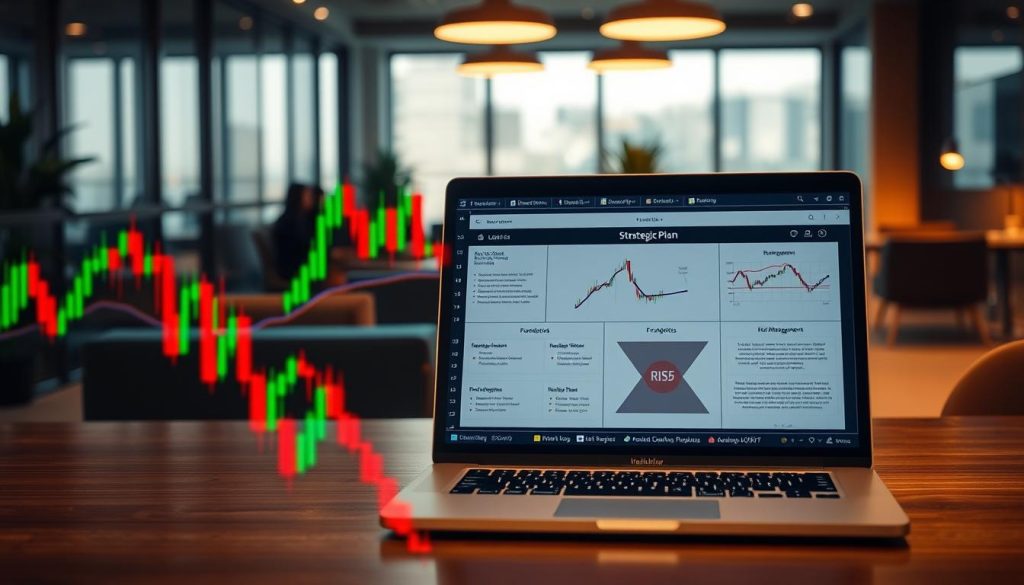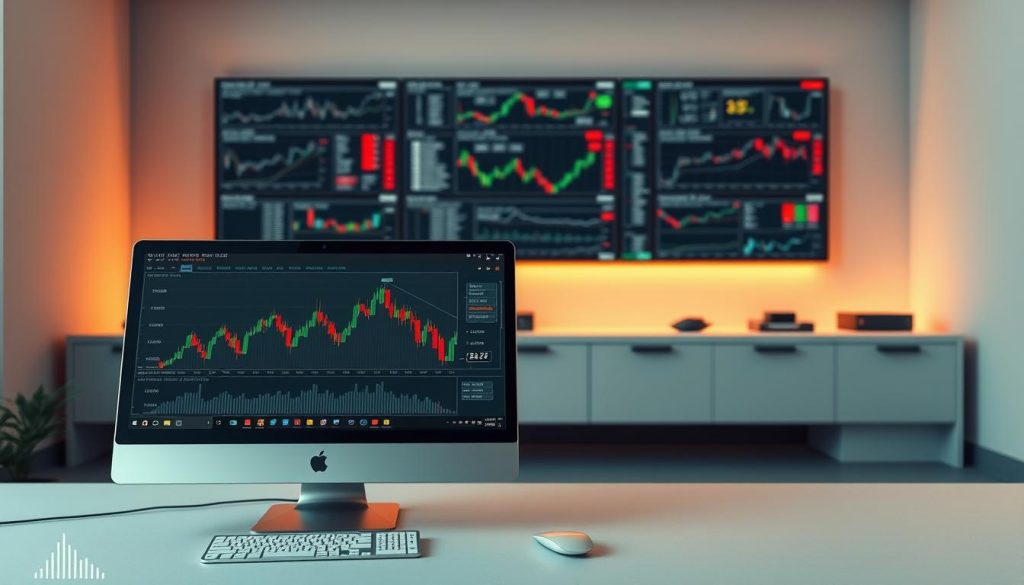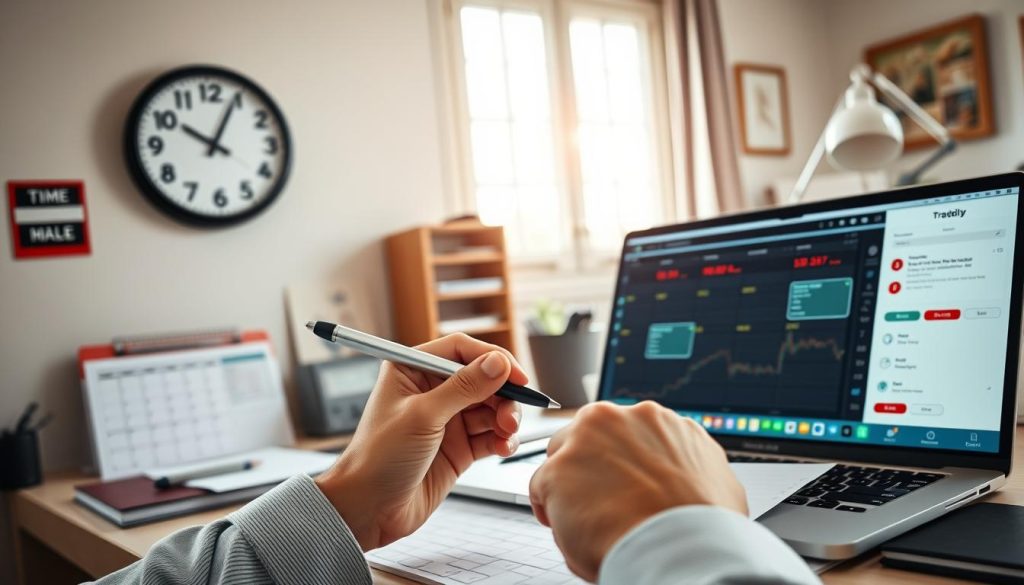How to Develop a Trading Plan for Prop Firm Challenges

Entering a prop firm challenge needs careful planning and a detailed trading plan. Successful traders know that a solid trading plan is key to passing tough prop firm tests. These tests check not just trading skills but also how well you manage risks and keep up consistent results.
For traders facing a prop firm challenge, a good strategy is more than just guessing the market. It’s about creating a detailed plan that shows you’re a pro trader and meets the challenge’s needs. The challenge requires precision, being able to adapt, and a deep grasp of market trends.
Building a strong trading plan includes several important parts. Traders must use good risk management, set clear goals, and have a method for analyzing the market. Being well-prepared is what sets successful traders apart from those who don’t make it in these tough tests.
Key Takeaways
- Create a structured trading plan tailored to prop firm challenge requirements
- Develop robust risk management strategies
- Understand challenge-specific performance metrics
- Practice disciplined emotional control during trading
- Continuously refine and optimize trading techniques
Understanding Prop Firm Challenge Requirements
Prop firm challenges have their own rules and requirements. Traders need to understand these rules to succeed. They must analyze the specific rules that affect their trading.
These challenges test traders’ skills in a structured way. They look at more than just how well a trader does. They also check how well a trader manages risk and shows consistent profits.
Common Rules and Restrictions
Traders face important restrictions that can affect their success:
- Prohibited trading instruments and strategies
- Maximum daily loss limits
- Minimum trading days requirements
- Restrictions on news trading
Profit Targets and Drawdown Limits
Each prop firm has its own profit targets and drawdown limits. These include:
- Minimum profit target (usually 8-10% of initial account balance)
- Maximum acceptable drawdown (typically 5-10%)
- Consistent trading performance expectations
“Success in prop firm challenges is about consistent, controlled trading, not wild speculation.” – Professional Trader
Time Frame Constraints
The length of the challenge and when you can trade are key. Most prop firms have strict rules, such as:
- Challenge duration: 30-60 days typically
- Specific trading hour requirements
- Mandatory minimum and maximum trading days
Knowing these rules is crucial. It helps traders plan a strategy that meets the prop firm’s expectations. This increases their chances of getting funded.
Essential Components of a Successful Trading Strategy
Creating a winning trading plan needs careful thought about many important parts. The key elements of a trading strategy are vital for tackling prop firm challenges. Traders must build a detailed plan that covers market trends and their own strengths.
“A robust trading strategy is not about perfection, but about consistent and disciplined execution.” – Professional Trader Insight
The main parts of a trading strategy are:
- Clear Market Analysis Methodology
- Precise Entry and Exit Criteria
- Defined Risk Management Parameters
- Adaptable Trading Approach
A good trading plan needs smart yet doable strategies. Traders should craft a method that gives them an edge in the market. It should also be flexible to handle market changes.
| Strategy Component | Key Characteristics | Implementation Difficulty |
|---|---|---|
| Market Analysis | Technical and Fundamental Indicators | Medium |
| Risk Management | Position Sizing, Stop Losses | High |
| Trading Psychology | Emotional Discipline | Very High |
Successful trading plans need to keep improving. Backtesting and forward testing are key ways to check if a strategy works. They help make sure the strategy is reliable before facing prop firm challenges.
Risk Management Fundamentals for Prop Challenges
Prop firm challenges need a strong risk management plan. This plan keeps your trading capital safe while aiming for big profits. Traders know that managing risk is key to lasting success.

Good risk management is more than just keeping your money safe. It’s about a smart plan to protect your investments and grow them steadily.
Position Sizing Guidelines
Position sizing is vital in prop trading challenges. Here are some important rules:
- Never risk more than 1-2% of your total account balance on a single trade
- Calculate position size based on your account balance and risk tolerance
- Use precise mathematical calculations to determine optimal trade sizes
Stop Loss Placement Strategies
Stop loss strategies are key to controlling losses and keeping your account safe. Here are some strategies:
- Place stops at key technical levels
- Use percentage-based stop loss methods
- Implement trailing stops to protect profits
Understanding Risk-Reward Ratios
| Risk-Reward Ratio | Potential Outcome | Recommended Approach |
|---|---|---|
| 1:2 Ratio | Moderate Risk | Suitable for Conservative Traders |
| 1:3 Ratio | Balanced Risk | Ideal for Most Prop Challenges |
| 1:4 Ratio | High Potential | Aggressive Trading Strategy |
“Risk management is not about preventing losses, but about managing them strategically.” – Professional Trader
Success in prop firm challenges comes from a disciplined risk management approach. Position sizing, stop loss strategies, and careful risk-reward analysis are crucial. They help traders overcome challenges and reach their full potential.
Market Analysis Techniques for Challenge Success
Mastering market analysis is key for traders in prop firm challenges. They use technical, fundamental, and market analysis to craft strong trading plans. These plans help them succeed in various market conditions.
- Technical analysis with price charts and indicators
- Fundamental analysis of economic signals
- Sentiment analysis of market psychology
- Trend identification strategies
Technical analysis gives traders tools to understand market trends. Important techniques include:
- Candlestick pattern recognition
- Tracking support and resistance levels
- Moving average convergence
- Relative strength index (RSI) measurements
“The market is never wrong; opinions are.” – Jesse Livermore
Good market analysis needs a mix of methods. Traders should create a detailed plan to evaluate market conditions. They should use both numbers and insights to make informed decisions.
| Analysis Type | Key Focus Areas | Primary Tools |
|---|---|---|
| Technical Analysis | Price Patterns | Charts, Indicators |
| Fundamental Analysis | Economic Indicators | News, Reports |
| Sentiment Analysis | Market Psychology | Social Media, Trading Volume |
Professional traders know that no single method gives full insights. Mixing different approaches makes a stronger trading strategy.
Setting Realistic Profit Goals and Milestones
Creating a strategic plan for profit goals is key to success in prop firm challenges. Traders need a structured plan that breaks down big goals into smaller targets. It’s important to aim high but stay realistic and keep up a steady performance.

Setting goals well means understanding performance metrics and challenge needs. Traders should aim for a flexible plan that can change as needed.
Daily Profit Targets
Setting daily profit goals helps traders stay focused and track their progress. Here are some tips for setting achievable daily targets:
- Figure out a safe daily profit percentage
- Go for steady small wins over big, risky bets
- Make sure daily goals match the challenge’s big picture
“Success in prop firm challenges comes from disciplined, measured approach to trading goals.” – Professional Trader
Weekly Performance Metrics
Looking at weekly performance gives valuable insights into how well your trading strategy works. Develop a detailed review process that looks at:
- Total profit and loss
- Consistency in winning
- How well you manage risk
- If you follow the challenge rules
Overall Challenge Objectives
Prop firm challenges need a strategic plan for profit goals. Traders should make a detailed plan that:
- Breaks down total profit needs
- Creates clear performance standards
- Allows for a flexible trading strategy
Remember, success in prop firm challenges is about consistent performance and strategic goal management.
How to Develop a Trading Plan for Prop Firm Challenges
Making a solid trading plan is key to doing well in prop firm challenges. A good plan can mean the difference between success and failure in these tough tests.

To create a winning strategy, traders must think deeply about several important areas. They need a detailed plan that covers all the bases:
- Choosing the right markets and analyzing them
- Having clear rules for when to enter and exit trades
- Setting precise limits for risk
- Tracking how well the plan is working
“A trading plan is your roadmap to success in prop firm challenges. Without it, you’re navigating blindfolded.” – Professional Trader
The heart of making a trading plan is to create a method that can handle the high standards of prop firm challenges. Traders should focus on:
- Setting clear goals for trading
- Using consistent rules for managing risk
- Sticking to a strategy that is flexible yet disciplined
| Key Plan Component | Critical Considerations |
|---|---|
| Risk Management | Maximum risk per trade (1-2%) |
| Entry Rules | Clear, repeatable criteria |
| Exit Strategy | Predefined profit targets and stop-loss levels |
Professional traders know that success isn’t about making perfect trades. It’s about being consistent and disciplined. Your trading plan should grow with the market but always stick to its core principles of risk and strategy.
Psychology and Emotional Control During Challenges
Prop firm challenges are not just about trading skills. They test your mental limits, requiring top-notch emotional control and stress handling. Successful traders know that trading psychology is key to steady performance.

Trading psychology is about keeping your mind calm in tense market situations. Emotional ups and downs can cause hasty decisions that harm your strategy.
Managing Trading Stress
Stress management is vital for prop firm challenge success. Traders can use several methods to stay calm:
- Practice daily meditation
- Use deep breathing exercises
- Set realistic expectations
- Limit screen time
Maintaining Discipline
“Discipline is the bridge between goals and accomplishment.” – Jim Rohn
Keeping discipline means sticking to your trading plan. Emotional control stops you from deviating, keeping your account safe from reckless trades.
Recovery from Losses
Recovering from losses is a big part of trading psychology. Traders need to build mental toughness to get over tough trades.
| Loss Recovery Strategy | Key Actions |
|---|---|
| Emotional Reset | Take a break, reassess strategy |
| Analytical Review | Examine trade rationale objectively |
| Risk Management | Adjust position sizing |
By focusing on trading psychology, emotional control, and stress management, traders can tackle prop firm challenges with more confidence and consistency.
Trading Journal Documentation Methods
Successful prop firm traders know how important a detailed trading journal is. It helps track performance and document trades. A good journal turns raw data into useful insights, helping traders improve their strategies and avoid mistakes.

- Trade entry and exit points
- Position sizes
- Market conditions
- Emotional state during trading
- Reasons for trade decisions
“Your trading journal is a roadmap to improvement. Every trade tells a story – learn from it.” – Professional Trading Mentor
Digital tools have changed how we document trades. Modern trading journal platforms have advanced features like:
| Feature | Benefit |
|---|---|
| Automated Trade Logging | Reduces manual data entry errors |
| Performance Analytics | Provides detailed insights into trading patterns |
| Visual Reporting | Helps identify strengths and weaknesses |
It’s key to regularly review your journal. Set aside dedicated time weekly to analyze your trading performance. Look for patterns, emotional triggers, and ways to improve your strategy. This approach turns your journal into a powerful tool for growth.
Backtesting Your Strategy Before the Challenge
Successful prop firm traders know how key backtesting is before a trading challenge. It lets them check their strategies with past data. This gives them important insights into how well their strategies might do.

To backtest well, traders follow a few important steps. These steps help them make their strategies better and lower risks:
- Collect comprehensive historical market data
- Define clear entry and exit rules
- Simulate trading conditions accurately
- Evaluate strategy performance objectively
Historical Data Analysis Techniques
Traders use various methods to check how good their strategies are. These methods show what works well and what doesn’t.
| Analysis Method | Key Benefits | Potential Limitations |
|---|---|---|
| Manual Backtesting | Detailed observation | Time-consuming |
| Automated Backtesting | Quick results | Potential over-optimization |
| Monte Carlo Simulation | Statistical robustness | Complex implementation |
Performance Optimization Strategies
To make strategies better, traders need a careful plan. They should:
- Analyze win rates and profit factors
- Look for patterns in performance
- Change risk management settings
“Backtesting is not about finding a perfect strategy, but understanding its behavior under various market conditions.” – Professional Trading Mentor
Strategy Refinement Process
The last step is to keep making your strategy better. This means always testing, analyzing, and tweaking your approach with past data. Successful traders see backtesting as a never-ending chance to learn and adapt.
Time Management and Trading Schedule

Mastering time management is key to success in prop firm challenges. Traders need a strategic trading schedule that balances market chances with personal life. The goal is to create a structured plan that boosts efficiency without leading to burnout.
“Time is the most critical resource in trading. Manage it wisely, and success will follow.” – Professional Trader
Effective time management for traders involves several key strategies:
- Establish a consistent daily trading routine
- Define clear time blocks for market analysis
- Create dedicated periods for strategy review
- Implement strict work-life balance boundaries
Your trading schedule should fit different market sessions and your energy levels. Peak performance hours vary among traders. Some do best in the morning, while others shine in the evening.
Key parts of a great trading schedule include:
- Pre-market prep (30-60 minutes)
- Active trading window
- Post-market analysis and review
- Continuous learning and strategy refinement
Global traders face extra time management hurdles due to different market zones. Using trading tools and technology can help align your schedule. This way, you can make the most of trading opportunities while keeping a healthy work-life balance.
“A well-structured trading schedule is your roadmap to consistent performance and personal sustainability.” – Trading Performance Expert
The aim is not just to trade but to trade smartly. A disciplined time management approach can greatly boost your success in prop firm challenges.
Adapting to Different Market Conditions
Successful prop firm traders know that being adaptable is key. They must have strategies that work in many market conditions. This includes both high volatility and stable, range-bound markets.
Traders need a solid plan for dealing with market changes. They must stay quick and flexible to adjust their trading tactics as needed.
Volatile Market Strategies
In volatile markets, traders should use these strategies:
- Reduce position sizes to manage increased risk
- Use wider stop-loss parameters
- Focus on highly liquid instruments
- Implement protective options strategies
Range-Bound Trading Approaches
In markets that stay within certain limits, trend following doesn’t work as well. Traders can improve by:
- Identifying clear support and resistance levels
- Using oscillating indicators like RSI
- Implementing mean reversion strategies
- Setting precise entry and exit points
Trend Following Techniques
For successful trend following, a strategic plan is needed:
| Technique | Key Characteristics | Implementation |
|---|---|---|
| Moving Average Crossovers | Identify trend direction | Use 50 and 200-day moving averages |
| Momentum Indicators | Measure trend strength | Analyze MACD and ADX |
| Price Action Analysis | Confirm trend signals | Evaluate higher highs and lower lows |
“The market is always right, and your job is to follow the trend, not predict it.” – Professional Trader
By learning these adaptability techniques, traders can boost their success in prop firm challenges. They develop a strong, flexible trading strategy.
Common Mistakes to Avoid During Challenges
Prop firm trading challenges are tough places where even skilled traders can make mistakes. It’s key to know and avoid these errors to succeed in these high-pressure situations.
Traders often face several pitfalls that can ruin their success. The biggest mistakes usually come from bad psychology and strategy choices.
- Overtrading when feeling emotional or desperate
- Ignoring predefined risk management rules
- Abandoning the original trading strategy mid-challenge
- Failing to adapt to changing market conditions
“The difference between success and failure in prop firm challenges often lies in discipline and self-awareness.” – Professional Trading Mentor
Psychological issues can lead to bad trading habits. Confirmation bias makes traders look for info that backs their views. The gambler’s fallacy causes them to make poor choices during losing times.
| Common Trading Mistake | Potential Consequence |
|---|---|
| Revenge Trading | Rapid Account Depletion |
| Inconsistent Position Sizing | Uncontrolled Risk Exposure |
| Ignoring Stop Loss Levels | Significant Capital Loss |
To do well in prop firm challenges, traders need solid strategies. They focus on managing risk well, not taking big risks. Keeping calm and following a good plan are crucial in these tough environments.
Conclusion
Success in prop firms comes from a solid trading plan. It needs smart thinking, strict following of rules, and always getting better. Traders who plan well have a better shot at handling tough markets and passing tough tests.
A good trading plan is key. It needs deep market knowledge, careful risk taking, and staying strong mentally. Winners see these tests as chances to grow and get better at trading.
Getting better is the heart of trading success. Every challenge in prop firms is a chance to learn and improve. By always learning, traders turn failures into lessons that make them better in the long run.
Prop firm challenges are more than just tests. They check a trader’s skills, flexibility, and planning. To succeed, you need to stay focused, prepare well, and keep your cool. Traders who do this will do great in prop firm tests and future trading.
FAQ
What is a prop firm challenge?
A prop firm challenge is a test where traders show their skills. They trade with fake money to prove they can make profits and manage risks. This is to get a chance to trade real money with a proprietary trading firm.
How long do prop firm challenges typically last?
Prop firm challenges usually last from 30 to 60 days. During this time, traders must hit specific profit goals and manage risks well to pass the test.
What are the most common profit target requirements?
Prop firms often ask traders to make 8% to 10% profit on the initial account balance. They also have rules about trading regularly and keeping losses small.
How important is risk management in prop firm challenges?
Risk management is key in prop firm challenges. Traders must stick to drawdown limits, usually 4-10% of the account balance. They also need to trade consistently and follow a disciplined strategy.
Can I use automated trading systems in prop firm challenges?
It depends on the prop firm’s rules. Some allow Expert Advisors (EAs) or algorithmic trading. Others require manual trading. Always check the specific rules before joining.
What trading instruments are typically allowed in prop challenges?
Prop firm challenges usually let traders use forex, futures, indices, and sometimes cryptocurrencies. But, some exotic pairs or very volatile instruments might be off-limits.
How many trading days are required during a challenge?
Most challenges need traders to trade for at least 5-10 days. This shows they can make money in different market conditions.
What happens if I pass the prop firm challenge?
If you pass, you get a funded account with the prop firm. You can then trade with the firm’s money. You’ll share profits according to an agreement.
How much capital can I trade after passing a challenge?
You can start with $5,000 to $200,000. Some firms offer more money if you keep performing well and follow their risk rules.
What are the most critical factors for success in a prop firm challenge?
Success needs disciplined risk management, a solid trading plan, and emotional control. You must also perform consistently, follow the firm’s rules, and keep losses low while hitting profit targets.
